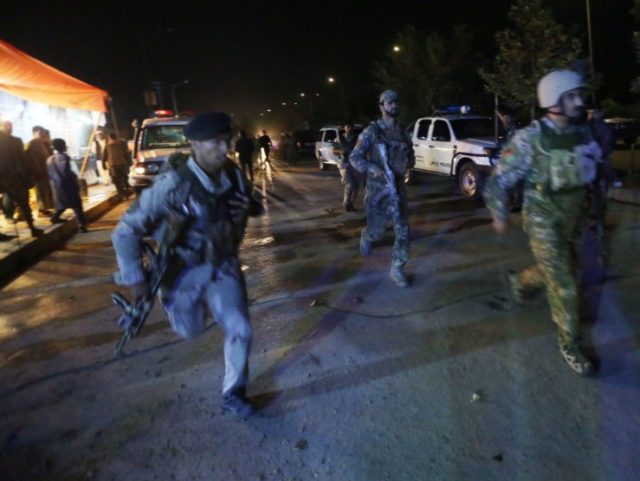The American University of Afghanistan in Kabul is under attack, a testament to the “growing insecurity” in the Afghan capital recently highlighted by a watchdog agency appointed by Congress and the Pentagon.
In similar statements, spokesmen from the Pentagon and the U.S.-NATO mission in Afghanistan told Breitbart News that a “small number” of U.S.-led coalition advisors “are assisting their Afghan counterparts as Afghan forces are responding to develop the situation further. These advisors are not taking a combat role, but advising their Afghan counterparts.”
The advisers are American, the Pentagon has confirmed.
TOLO News reports:
Dozens of students and staff are believed to be trapped inside the university building… Reports also indicate that there are casualties but no official confirmation has as yet been received.
U.S. citizens have been warned against traveling to Afghanistan by the American Embassy there, which notes that the U.S.-led coalition and American citizens have been targeted by jihadists in Kabul.
Earlier this month, two professors, an American and an Australian, were abducted on their way home from the American University by gunmen dressed as members of the Afghan National Defense and Security Forces (ANDSF), which includes police and military units.
No specific group claimed responsibility for the August 7 kidnapping.
However, both the Taliban and most recently the Islamic State (ISIS/ISIL) branch in the Afghanistan-Pakistan region, known as the Khorasan Province (ISIL-K/IS-KP), have proven capable of attacking the heavily-guarded Kabul, which houses a U.S.-led coalition base.
At the end of July, the Special Inspector General for Afghanistan Reconstruction (SIGAR), a U.S. watchdog agency reported:
A sign of the growing insecurity in Kabul are the increasing number of concrete blast walls that surround government buildings, foreign embassies, companies, and the homes of wealthy residents.
The U.S. Embassy in Kabul notes:
U.S. Embassy personnel are restricted from traveling to all locations in Kabul except the U.S. Embassy and other U.S. government facilities unless there is a compelling government interest in permitting such travel that outweighs the risk.
In late July, ISIL-K launched an attack in Kabul, dubbed the deadliest of the nearly 15-year-old war. At least 80 people were killed and 231 others injured.
The Taliban and ISIL-K both claimed responsibility for a June 20 attack in Kabul, considered one of the deadliest against foreign workers since the war began in October 2001. At least 14 Nepalese security guards for the Canadian Embassy were killed and nine others wounded when the terrorists struck a bus that was also carrying Indian nationals.
The Taliban remains the strongest jihadist group in Afghanistan and is responsible for more attacks in Kabul than any other terrorist organization.
Known for targeting students, particularly women, the Taliban recently decapitated “a young university student in northern Faryab province of Afghanistan and used his corpse [as] a Body-borne Improvised Explosive Device (BBIED)” against Afghan forces, reports Khaama Press (KP).
It adds:
According to the local officials in Faryab, the corpse of the university student was left on a roadside after placing a remote controlled Improvised Explosive Device (IED) in his body.
Provincial governor’s spokesman Javid Bidar…further added that the move by the Taliban militants is apparently aimed at discouraging the university students from pursuing their higher education.
Despite the 15-year-old effort against terror in Afghanistan by the U.S.-led coalition, the Taliban remains capable of conquering territory and inflicting record-levels of casualties on Afghan civilians and the Afghan security forces that continue to suffer from capability gaps.
According to the Pentagon, “the Taliban likely will continue to test the ANDSF aggressively throughout the rest of 2016” and launch high-profile attacks (HPAs) and spread its influence in Kabul and other traditional areas of operation.
The U.S. military recently increased its military presence in Afghanistan in response to a resilient Taliban and a growing ISIL-K.
Although HPAs in areas like Kabul have decreased this year, they have proven to be deadlier.
SIGAR notes:
According to DOD [U.S. Department of Defense], the capital city experienced 10 high-profile attacks between December 1, 2015, and May 20, 2016, with 50 others across the rest of Afghanistan. This represents a 41% decrease in high-profile attacks in Kabul compared to 26 during the same period a year earlier.
The Pentagon adds:
Despite this decrease, the Taliban are still capable of conducting larger HPAs in Kabul that garner media attention and a major Afghan government response…
Although the number of HPAs in Kabul and across Afghanistan has decreased in comparison to the last two years, the number of both ANDSF and civilian casualties caused by HPAs has increased. This demonstrates the increased lethality of insurgent attacks – person-borne and suicide vehicle-borne IED attacks in particular – as well as a transition towards an increasingly urban conflict.

COMMENTS
Please let us know if you're having issues with commenting.